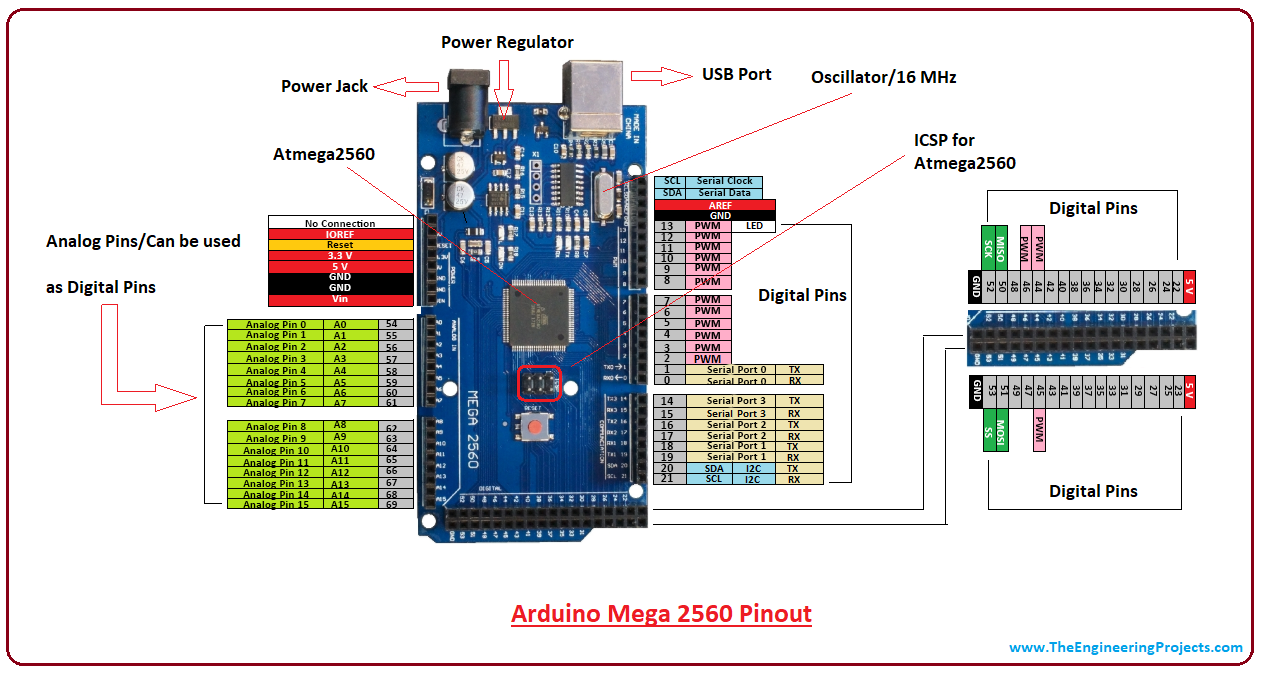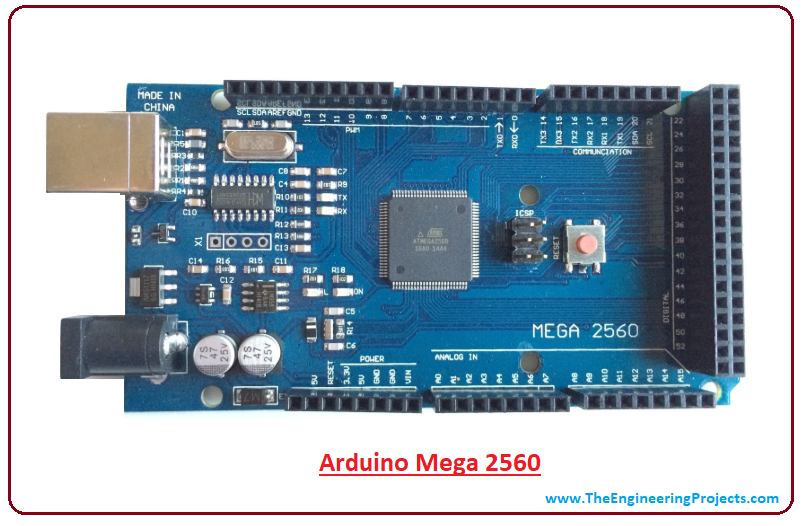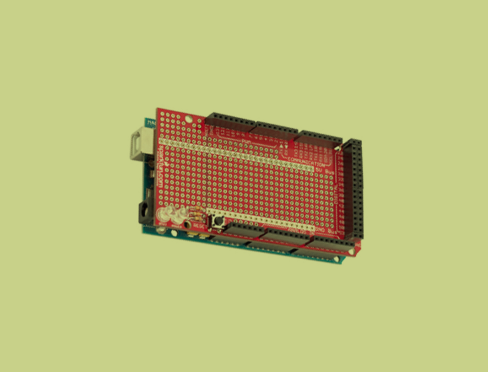
I have updated articles previously on Arduino Uno, Arduino Nano, and Arduino Pro Mini. All these boards function similarly in one way or the other. There are some basic features like PCB layout design, size, number of analog pins and breadboard friendly nature that make them different from each other. In terms of coding, all these boards are programmed in Arduino IDE software and you don't need to attach extra components or devices to put them in running condition. Everything is already built in the board that makes this device readily available. Just plug and play with the board as per your requirement. Here's the video presentation of Arduino Mega 2560:
All the boards mentioned above work perfectly for a number of Arduino Projects when you require a simple task to be completed with fewer I/O pins and memory. However, when the project goes complex, a board with less memory fails to complete the task. This is where Arduino Mega 2560 comes in handy. This board comes with 54 pins and 16 analog pins with more memory to store the code. Sounds crazy, isn't it? Thanks to technology that keep your covered in every aspect and provides support in any way when it comes to fulfilling your technical needs.
I'll try to cover each and everything related to Arduino Mega 2560, what is this about, the main features, working, technical specifications and everything you need to know. Let's jump right in.
| No. | Pin Number | Pin Description |
|---|---|---|
| 1 | D0 - D53 | 54 Digital Input / Output Pins. |
| 2 | A0 - A15 | 16 Analog Input / Output Pins. |
| 3 | D2 - D13 | 12 Pulse Width Modulation ( PWM ) Pins. |
| 4 | Pin # 0 (RX) , Pin # 1 (TX) Pin # 19 (RX1) , Pin # 18 (TX1) Pin # 17 (RX2) , Pin # 16 (TX2) Pin # 15 (RX3) , Pin # 14 (TX3) | 4 Serial Communication Ports (8 Pins). |
| 5 | Pin # 50 ( MISO ) Pin # 51 ( MOSI ) Pin # 52 ( SCK ) Pin # 53 ( SS ) | SPI Communication Pins. |
| 6 | Pin # 20 ( SDA ), Pin # 21 ( SCL ) | I2C Communication Pins. |
| 7 | Pin # 13 | Built-In LED for Testing. |
- If you are planning to learn Arduino Nano Programming, then you must have a look at Introduction to Arduino IDE.
Other Arduino Boards:
You should also have a look at these other Arduino board, you might find them interesting as well. Compare their features and find the most suitable one for your project. Here's the list of other Arduino boards:| Where To Buy? | ||||
|---|---|---|---|---|
| No. | Components | Distributor | Link To Buy | |
| 1 | Arduino Mega 2560 | Amazon | Buy Now | |
Introduction to Arduino Mega 2560
- Arduino Mega 2560 is a Microcontroller board based on Atmega2560. It comes with more memory space and I/O pins as compared to other boards available in the market.
- There are 54 digital I/O pins and 16 analog pins incorporated on the board that make this device unique and stand out from others.
- Out of 54 digital I/O, 15 are used for PWM (pulse width modulation).
- A crystal oscillator of 16MHz frequency is added on the board.
- This board comes with USB cable port that is used to connect and transfer code from computer to the board.
- DC power jack is coupled with the board that is used to power the board. Some version of the Arduino board lacks this feature like Arduino Pro Mini doesn't come with DC power jack.
- ICSP header is a remarkable addition to Arduino Mega which is used for programming the Arduino and uploading the code from the computer.
- You can download the Arduino Mega 2560 datasheet bu clicking below button:

- This board comes with two voltage regulator i.e. 5V and 3.3V which provides the flexibility to regulate the voltage as per requirements as compared to Arduino Pro Mini which comes with only one voltage regulator.
- There is no much difference between Arduino Uno and Arduino Mega except later comes with more memory space, bigger size and more I/O pins.
- Arduino software called Arduino IDE is used to program the board which is a common software used for all boards belonged to Arduino family.
- Availability of Atmega16 on the board makes it different than Arduino Pro Mini which uses USB to serial converter to program the board.
- There is a reset button and 4 hardware serial port called USART which produces a maximum speed for setting up communication.
- The following figure shows the specifications of Arduino mega 2560.

- Arduino Mega is specially designed for the projects requiring complex circuitry and more memory space. Most of the electronic projects can be done pretty well by other boards available in the market which make Arduino Mega uncommon for regular projects. However, there are some projects that are solely done by Arduino Mega like making of 3D printers or controlling more than one motors, because of its ability to store more instructions in the code memory and a number of I/O digital and analog pins.
- There are three ways to power the board. You can either use a USB cable to power the board and transfer code to the board or you can power it up using Vin of the board or through Power jack or batter.
- Last two sources to power the board are required once you already built and compile code into the board through USB cable.
- This board comes with resettable polyfuse that prevents the USB port of your computer from overheating in the presence of high current flowing through the board. Most of the computers come with an ability to protect themselves from such devices, however, the addition of fuse provides an extra layer of protection.
- It can be used either way i.e. for creating stand-alone projects or in combination with other Arduino boards. Most complex projects can be created using this board.
Arduino Mega 2560 Pinout
- Following figure shows the pinout of Arduino Mega 2560:

- Each pin comes with a specific function associated with it. All analog pins can be used as digital I/O pins.
- Designing of a project using Arduino Mega gives you the flexibility of working with more memory space and processing power that allows you to work with a number of sensors at once. This board is physically larger than other Arduino boards.
Arduino Mega 2560 Pin Description
- 5V & 3.3V. This pin is used to provide output regulated voltage around 5V. This regulated power supply powers up the controller and other components on the board. It can be obtained from Vin of the board or USB cable or another regulated 5V voltage supply. While another voltage regulation is provided by 3.3V pin. Maximum power it can draw is 50mA.
- GND. There are 5 ground pins available on the board which makes it useful when more than one ground pins are required for the project.
- Reset. This pin is used to reset the board. Setting this pin to LOW will reset the board.
- Vin. It is the input voltage supplied to the board which ranges from 7V to 20V. The voltage provided by the power jack can be accessed through this pin. However, the output voltage through this pin to the board will be automatically set up to 5V.
- Serial Communication. RXD and TXD are the serial pins used to transmit and receive serial data i.e. Rx represents the transmission of data while Tx used to receive data. There are four combinations of these serial pins are used where Serail 0 contains RX(0) and TX(1), Serial 1 contains TX(18) and RX(19), Serial 2 contains TX(16) and RX(17), and Serial 3 contains TX(14) and RX(15).
- External Interrupts. Six pins are used for creating external interrupts i.e interrupt 0(0), interrupt 1(3), interrupt 2(21), interrupt 3(20), interrupt 4(19), interrupt 5(18). These pins produce interrupts by a number of ways i.e. providing LOW value, rising or falling edge or changing value to the interrupt pins.
- LED. This board comes with built-in LED connected to digital pin 13. HIGH value at this pin will turn the LED on and LOW value will turn it off. This gives you the change of nursing your programming skills in real time.
- AREF. AREF stands for Analog Reference Voltage which is a reference voltage for analog inputs.
- Analog Pins. There are 16 analog pins incorporated on the board labeled as A0 to A15. It is important to note that all these analog pins can be used as digital I/O pins. Each analog pin comes with 10-bit resolution. These pins can measure from ground to 5V. However, the upper value can be changed using AREF and analogReference() function.
- I2C. Two pins 20 and 21 support I2C communication where 20 represents SDA (Serial Data Line mainly used for holding the data) and 21 represents SCL(Serial Clock Line mainly used for providing data synchronization between the devices)
- SPI Communication. SPI stands for Serial Peripheral Interface used for the transmission of data between the controller and other peripherals components. Four pins i.e. 50 (MISO), 51 (MOSI), 52 (SCK), 53 (SS) are used for SPI communication.
Arduino Mega 2560 Dimensions
Follwoing figure shows the dimensions of the Arduino Mega 2560:
- Arduino Mega is comparatively larger than other boards available in the market. It comes 4-inch length and 2.1-inch width. However, USB port and power jack are slightly extended from the given dimensions.
Shield Compatibility with Arduino Mega 2560
- Arduino Mega is compatible with most of the shields designed for other Arduino boards.
- Before you intend to use a shield, make sure the operating voltage of the shield is compatible with the board voltage. Most of the shields operate at 3.3V or 5V which is compatible with this board, however, shields with higher operating voltage can damage the board.

- Also, the header distribution of the shield must resonate with the pin distribution of the board, so you can simply attach the shield with the board and make it in a running condition.
Arduino Mega 2560 Programming
- Arduino Mega 2560 can be programmed using Arduino Software called IDE which supports C programming.
- The code you make on the software is called sketch which is burned in the software and then transferred to the board through USB cable.
- This board comes with a built-in bootloader which rules out the usage of an external burner for burning the code into the board.
- The bootloader communicates using STK500 protocol.
- Once you compile and burn the program on the board, you can unplug the USB cable which eventually removes the power from the board. When you intend to incorporate the board into your project, you can power it up using power jack or Vin of the board.
- Multitasking is another feature where Arduino mega comes handy. However, Arduino IDE Software doesn't support multitasking feature but you can use other operating systems like FreeRTOS and RTX to write C program for this purpose. This gives you the flexibility of using your own custom build program using ISP connector.
Arduino Mega 2560 Applications
Arduino Mega 2560 is an ideal choice for the projects requiring more memory space to used with more number of number pins on the board. Following are the main applications of the Arduino mega boards.- Developing 3D printer
- Controlling and handling more than one motors
- Interfacing of number of sensors
- Sensing and detecting temperature
- Water level detection projects
- Home automation and security systems
- Embedded Systems
- IoT applications
- Parallel programming and Multitasking



